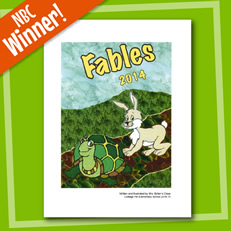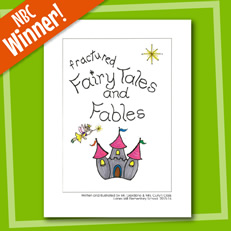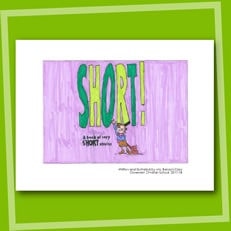 Fairy tales are some of the first stories that kids are exposed to, they are something most children learn to appreciate from a very early age and these book project ideas are great for almost every level of elementary student.
Fairy tales are some of the first stories that kids are exposed to, they are something most children learn to appreciate from a very early age and these book project ideas are great for almost every level of elementary student.
Your students have probably heard these tales as bedtime stories before they even began school and, with so many of the fairy tales translated in animated features, such “Cinderella,” “Beauty and the Beast” and “Emperor’s New Clothes,” it’s hard to not be familiar with a few..
No matter if you teach first or sixth grade, there’s an opportunity to create some interesting and fun writing prompts for your students that are inspired by fairy tales. We put together three fairy tale-themed ideas for elementary students that can easily be published into awesome classbooks!
3 Book Project Ideas Inspired by Fairy Tales
Fairy tales conjure up visions of princesses and castles, magic beans and big bad wolves, so these projects certainly are the perfect opportunity for your students to demonstrate their creativity.
Book Idea #1: Write a short fable that includes an important lesson learned in the end.
While the length of the short fairy tale story may vary depending on the grade level of your students, this book project is a great way to introduce how to write a short story that has a beginning, middle and end.
Besides reviewing a few example fairy tales that end with an important lesson, such as “The Princess & the Pea” or “The Three Little Pigs,” it’s important to discuss the elements that make up a typical fairy tale. This worksheet can help your students map out the parts of the fairy tales that have been talked about in class. This will give them a visual understanding of the sequence of events that happen in fairy tales. We also have a slew of printable worksheets in our teacher’s lounge organized by grade level that can help your students with story and character development.
PROJECT IDEA
Remind your students to work out what the important lesson will be by the end of the fairy tale and then they can start writing! If you are planning to make these projects into a classbook, this book idea offers a great opportunity to work on drafting, editing and revisions with your students.
Once the fairy tale is finalized, have your students draw a book cover for their new fairy tale. Then take the story and illustration that each student created to put together your class’s own collection of fairy tales in a classbook. Your students will be thrilled to see their fairy tales bound and published.
Book Idea #2: Take your favorite fairy tale and rewrite it to fit modern times.
Whether your students want to update the bread crumb trail to using Google Maps in “Hansel and Gretel” or have the Evil Queen encourage Snow White to eat some poisonous kale, your students can have lots of fun putting their own spin on traditional fairy tales.
Providing a few examples of how to update a story might be helpful to get your students thinking about all the ways to modernize their chosen fairy tales. From carriages to electric cars and glass slippers to sneakers, there are lots of ways to update a fairy tale as well as make it their own.
There are many modernized versions of fairy tales available that would provide some excellent inspiration.
- “Interstellar Cinderella” by Deborah Underwood
- “Ninja Red Riding Hood” by Corey Rosen Schwartz
- “Goldilocks and the Three Dinosaurs” by Mo Willems
PROJECT IDEA
After your students write their modernized fairy tales, have them finish the project with an illustration depicting a scene from their story. Tell your students to have fun \ showing how characters might look and dress in today’s world. Once all of the modern tales and illustrations are completed, publish their work together to create an excellent classbook so that you and your students will remember this cool project for years to come.
Book Idea #3: Describe your favorite fairy tale character. What is their personality like? What do they like to do? What can we learn from them?
This particular book idea is a chance to help your students grasp the idea of character traits. Character traits are not something the author usually spells out for the reader, defining a character’s traits is much more of an abstract idea for your students to understand.
However, many fairy tales contain characters that can be easily defined, so it makes it easier to break them apart and use them as examples to talk about their traits. For instance, you could put up a picture of a character from a fairy tale, such as the tortoise from “The Tortoise and the Hare” and brainstorm as a class what words describe him both on the outside and inside.
Once they understand what defines character traits, then you can talk about what you learned from characters by using the same story example again. Ask your students what they learned from the tortoise’s actions, and then you can contrast that with the hare and his actions.
PROJECT IDEA
Have your students take this writing exercise a step further and use their imaginations to add in extra details about their favorite fairy tale character that the stories may not have provided. Here’s where they can really have fun and write about how Little Red Riding Hood loves playing soccer and likes red uniforms best.
Before they finish this project, have your students create a drawing of their character—one that captures a bit of the character’s personality and hobbies. The finished writing piece and illustration would make an excellent classbook. Your students will get excited and be motivated to give it their all when you let them know at the end they’ll be published authors!
Additional resources
If you’re looking for more ideas to inspire your students to write, visit our online teacher’s lounge. We’re here to support you and your desire to help your students love writing.
Be sure to sign up to receive your free classbook publishing kit while you’re on our site. Your students will thank you when they see their very own classbook!








